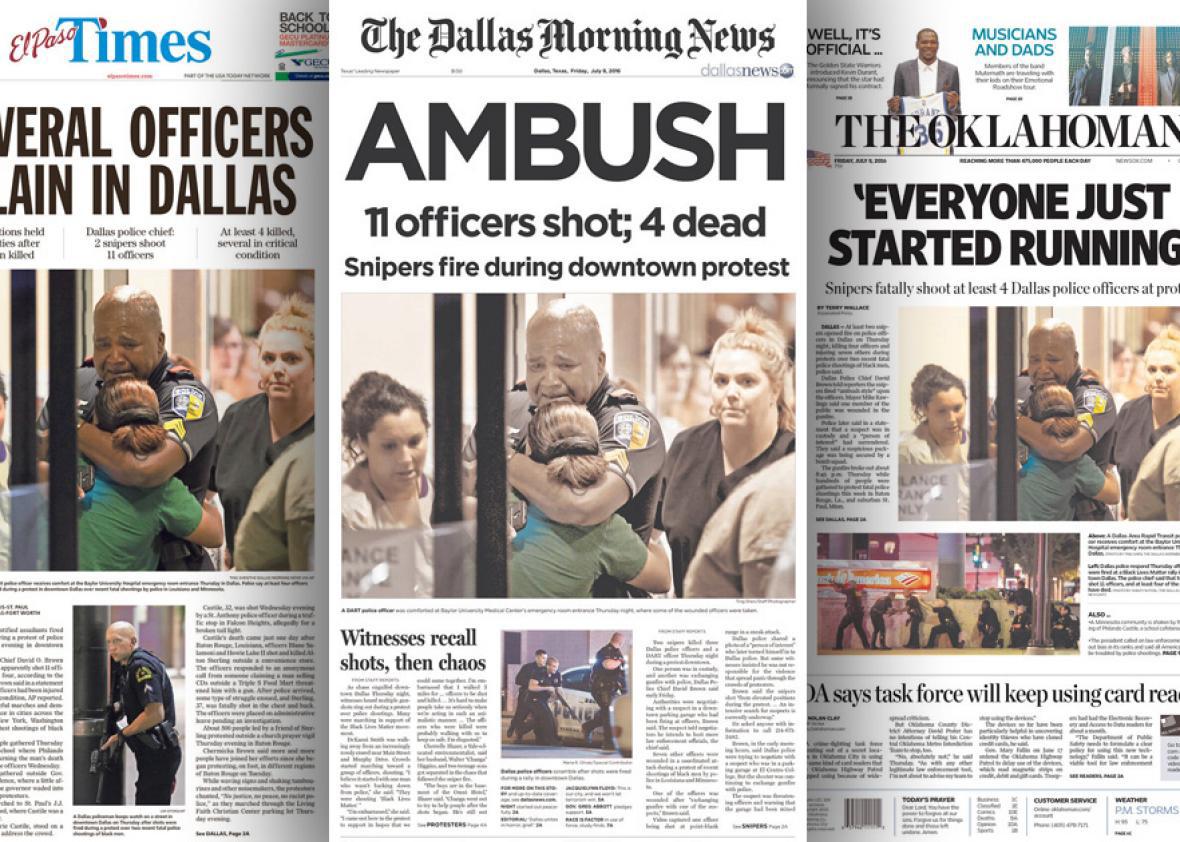On the morning after the shooting in Dallas that killed five police officers and left seven officers and two civilians wounded, people all across the country woke up to a torrent of pictures and videos. But one photograph—an image of a distraught police officer hugging a woman in a busy hospital emergency room—became the tragedy’s defining visual. The photo was shared thousands of times on social media and featured on the front pages of newspapers across the country, including the Dallas Morning News, the St. Louis Post-Dispatch, the Kansas City Star, and the Seattle Times.
The photo was captured by Ting Shen, an intern at the Morning News, using a Canon EOS-1DX with an EF 300mm f/2.8 L IS USM II lens. The 27-year-old graduated from Columbia College Chicago in 2015 with a degree in photo journalism. In 2014 he spent about a month covering protests in Ferguson, Missouri, for China’s Xinhua News Agency.
I spoke to Ting Shen on Friday about the moment he saw the image, the atmosphere at the hospital, and how he feels about the attention his photo is receiving. The conversation has been edited and condensed for clarity.
Laura Wagner: What was it like in the moment when you took the photo, and what were you thinking about what was going on around you?
Ting Shen: It was a hospital and people were tense, kind of nervous. They were shocked—people were shocked. The police officers seemed nervous about their colleagues. I was just pacing around, seeing if there were any images happening. I kind of previsualized that maybe something like that might happen, but I didn’t know it was going to happen there. I wasn’t standing around the same location as the other media was. I paced around closer to the sidewalk by the ER, I had a straight view into the ER entrance, and then it happened. I heard something, I turned, I hear sobbing and I saw crying. I was like, that’s it. I saw the moment and immediately started shooting.
Was it the police officer you heard sobbing?
No, the black police officer is actually comforting another police officer, the woman, who was sobbing. She was a police officer, I’m not sure what unit, but I could see she is some kind of law enforcement because she has a weapon in her holster.
Was it just a single moment? How fleeting was it?
It didn’t last for more than a minute before they disappeared into the ER. It ended and then one police officer came over and said, “Can you please move?” Because it was a crime scene. There was a police cruiser that was involved that had a bullet hole and blood coming out, and I was close to it. So I moved away and shortly after they put a screen to block off the view into the ER, and I was like, OK, that’s it, that’s the frame of the night from the hospital.
Did you know the minute you took the photo that it was going to be an emblematic image?
I did not know until later. I thought my colleagues, the other staff photographers—Ashley Landis, G.J. McCarthy, and Smiley Pool—they were downtown at the rally, and I thought they would have gotten something better. They were risking their lives over there and I was just doing my duty as to being sent to the hospital. Originally I thought I’d go downtown, but we had enough people downtown already. So, I was just doing my part to tell the story.
What was it like for you being there. Were you focused on getting the photo? Were you feeling their pain?
I was like 50 or 60 feet away so there’s a certain amount of distance between you and the subject. You raise a camera, you do your job, you get into working mode, you shut down everything, and it gets stuff done. That’s pretty much it.
It doesn’t seem like congratulations is the right word to say, but the photo is moving and wrenching, and told an important part of this story. Do you feel like you helped let people know what was going on in Dallas?
Yes, it definitely helps put a face on this whole thing. Police officers are human, too. We are in the same boat together. Balance and balance. Suffering and suffering. There’s no difference between a police officer shooting a black man, and a black man, same thing with a police officer. They all have families, they all have friends, they all have loved ones. I really wish there was more I could do, but that’s our job. My job is to observe and document and tell the story and hopefully in the process we can make a difference.
As an intern myself, I was wondering what advice you have for other interns out there.
One good example from this is that I wanted to chase action, but no, that’s not my job. It was already being covered by other staffers. You have to trust your editors and they will lead you. Your job is to tell a story as a team when big things like this happen. I mean, we’re all here to get better and improve our careers, but we’re here to tell a story and that story is more important than your personal career.
